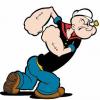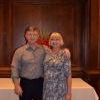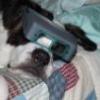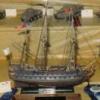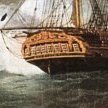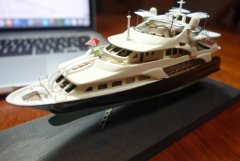MORE HANDBOOKS ARE ON THEIR WAY! We will let you know when they get here.
×
-
Posts
2,396 -
Joined
-
Last visited
Reputation Activity
-
 usedtosail reacted to _SalD_ in US Brig Syren by _SalD_ – FINISHED - 3/16" scale
usedtosail reacted to _SalD_ in US Brig Syren by _SalD_ – FINISHED - 3/16" scale
Chapter thirteen started off easy enough by making the two raised deck sections at the fore and main masts. I just added some small strips to finish off the edges. I’ll enlarge the mast holes later.
Then I moved onto the main fife rail. You know, Chuck seems like a really nice guy but then he goes and tells you to take these flimsy, 1/32” thick laser cut pieces of basswood, with holes in them no less, and round off their edges!!! Well all I can say is thank God for scotch. Maybe I just didn’t have a good method for doing this but these pieces are a true test of your patience. I walked away from these parts three or four times after breaking and gluing them back together the same amount of times. For those that are working on this model take your time and use very soft hands as you work on these parts. I finally finished both rail pieces and glued them together. They’re not the best but I ran out of scotch, only kidding, I have plenty.
For the legs I chucked a 1/16” dowel into my drill press and turned them to resemble the draw as close as possible. After cutting them to length I inserted pins into each end to help secure them in place. The parts were then stained and assembled. Belaying pins were added prior to mounting on the model.
-
 usedtosail reacted to pompey2 in how to work with teeny blocks???
usedtosail reacted to pompey2 in how to work with teeny blocks???
Richard
This is the Jig I use.
It is good for blocks, dead eyes, rigging hooks, eyes and just loops.
I clamp the base to the desk.
Then use a modified clothes peg, push a long pin through holes in the peg and the hole in the block.
Then the peg fits into the base. There is a 'dowel' on the peg and a hole for the pin.
Thread is fed through around the block, caught with a clip and an elastic band tensions the thread.
I then seize the number of turns I want using the traditional ‘trapped loop’ method.
I pull the end of the thread through the loop and pull out the loop. Push the siezing up tight to the block.
Take out of jig, paint with 50/50 PVA and trim when dry.
I'm sure some will think this overkill.
But I have done hundreds of blocks (even the smallest of sizes), loops, eyes etc. so have gotten pretty slick.
And I love the way the it looks.
Nick
-
 usedtosail reacted to Jerry's Admiral in H.M.S. BOUNTY by Jerry's Admiral - FINISHED - Amati - Scale 1:60
usedtosail reacted to Jerry's Admiral in H.M.S. BOUNTY by Jerry's Admiral - FINISHED - Amati - Scale 1:60
Good morning,
I didn't give my kids any homework assignments so that freed me up for a couple of hours last night to work on the Bounty. (No papers to grade) I used the time to highlight the hull's walnut planking by applying a couple of coats of satin finish. I hope you like the way it looks.
Have a nice day,
Charlene
-
 usedtosail got a reaction from popeye the sailor in USS Constitution by usedtosail - FINISHED - Model Shipways - scale 1/76
usedtosail got a reaction from popeye the sailor in USS Constitution by usedtosail - FINISHED - Model Shipways - scale 1/76
Now that I have the two holes through the bulwarks for the cat heads, I needed to add the details to them. I started with the sieves in the ends. My first attempt was to use the same method I used for the bitts - drill two holes for each sieve and connect them with an awl. Once these were painted black, they really didn't look good, so I went in another direction. I used a slitting disk in the Byrnes saw to cut three slots in the end of each cat head.
I then cut small pieces of thin wood and glued them into each slot after rounding the ends. You can see one of these pieces next to the cat head in this picture, but this cat head has all three pieces already in place.
I then put some thin CA on the slots to strengthen them, and used the True Sander to sand the ends down so the slots were the correct length. Some of the slots were long in the other direction, so I filled the extra length with wood filler. I then capped the end of the cat heads with a small piece of wood.
When it was dry, I sanded the wood piece to sit flush with the sides of the cat head and thinned it a little bit, and also sanded the wood filler.
I then repainted them black, and here is how they came out.
I should have taken a picture of the first ones to show the difference, but the sieves in these new ones look much better to me.
I tried last night to carve two cat head figures onto some strip wood to add to the ends of the cat heads, but the results were laughable. I will give it another go tonight with some different tools and maybe some different wood.
I have also finished installing the rail pieces and touched up all the black and green paint around them, and I am in the process of adding trim strips over the plank sheer at the open waist. I was going to leave these natural but after making them I think they will look better black, like the rest of the rails. I'll have a picture of these after I finish painting them and installing them.
Next up, after adding the rest of the details to the cat heads and installing them, is the head rails and trim boards.
-
 usedtosail got a reaction from Burroak in USS Constitution by usedtosail - FINISHED - Model Shipways - scale 1/76
usedtosail got a reaction from Burroak in USS Constitution by usedtosail - FINISHED - Model Shipways - scale 1/76
Now that I have the two holes through the bulwarks for the cat heads, I needed to add the details to them. I started with the sieves in the ends. My first attempt was to use the same method I used for the bitts - drill two holes for each sieve and connect them with an awl. Once these were painted black, they really didn't look good, so I went in another direction. I used a slitting disk in the Byrnes saw to cut three slots in the end of each cat head.
I then cut small pieces of thin wood and glued them into each slot after rounding the ends. You can see one of these pieces next to the cat head in this picture, but this cat head has all three pieces already in place.
I then put some thin CA on the slots to strengthen them, and used the True Sander to sand the ends down so the slots were the correct length. Some of the slots were long in the other direction, so I filled the extra length with wood filler. I then capped the end of the cat heads with a small piece of wood.
When it was dry, I sanded the wood piece to sit flush with the sides of the cat head and thinned it a little bit, and also sanded the wood filler.
I then repainted them black, and here is how they came out.
I should have taken a picture of the first ones to show the difference, but the sieves in these new ones look much better to me.
I tried last night to carve two cat head figures onto some strip wood to add to the ends of the cat heads, but the results were laughable. I will give it another go tonight with some different tools and maybe some different wood.
I have also finished installing the rail pieces and touched up all the black and green paint around them, and I am in the process of adding trim strips over the plank sheer at the open waist. I was going to leave these natural but after making them I think they will look better black, like the rest of the rails. I'll have a picture of these after I finish painting them and installing them.
Next up, after adding the rest of the details to the cat heads and installing them, is the head rails and trim boards.
-
 usedtosail got a reaction from Geoff Matson in USS Constitution by usedtosail - FINISHED - Model Shipways - scale 1/76
usedtosail got a reaction from Geoff Matson in USS Constitution by usedtosail - FINISHED - Model Shipways - scale 1/76
Now that I have the two holes through the bulwarks for the cat heads, I needed to add the details to them. I started with the sieves in the ends. My first attempt was to use the same method I used for the bitts - drill two holes for each sieve and connect them with an awl. Once these were painted black, they really didn't look good, so I went in another direction. I used a slitting disk in the Byrnes saw to cut three slots in the end of each cat head.
I then cut small pieces of thin wood and glued them into each slot after rounding the ends. You can see one of these pieces next to the cat head in this picture, but this cat head has all three pieces already in place.
I then put some thin CA on the slots to strengthen them, and used the True Sander to sand the ends down so the slots were the correct length. Some of the slots were long in the other direction, so I filled the extra length with wood filler. I then capped the end of the cat heads with a small piece of wood.
When it was dry, I sanded the wood piece to sit flush with the sides of the cat head and thinned it a little bit, and also sanded the wood filler.
I then repainted them black, and here is how they came out.
I should have taken a picture of the first ones to show the difference, but the sieves in these new ones look much better to me.
I tried last night to carve two cat head figures onto some strip wood to add to the ends of the cat heads, but the results were laughable. I will give it another go tonight with some different tools and maybe some different wood.
I have also finished installing the rail pieces and touched up all the black and green paint around them, and I am in the process of adding trim strips over the plank sheer at the open waist. I was going to leave these natural but after making them I think they will look better black, like the rest of the rails. I'll have a picture of these after I finish painting them and installing them.
Next up, after adding the rest of the details to the cat heads and installing them, is the head rails and trim boards.
-
 usedtosail got a reaction from thomaslambo in USS Constitution by usedtosail - FINISHED - Model Shipways - scale 1/76
usedtosail got a reaction from thomaslambo in USS Constitution by usedtosail - FINISHED - Model Shipways - scale 1/76
Now that I have the two holes through the bulwarks for the cat heads, I needed to add the details to them. I started with the sieves in the ends. My first attempt was to use the same method I used for the bitts - drill two holes for each sieve and connect them with an awl. Once these were painted black, they really didn't look good, so I went in another direction. I used a slitting disk in the Byrnes saw to cut three slots in the end of each cat head.
I then cut small pieces of thin wood and glued them into each slot after rounding the ends. You can see one of these pieces next to the cat head in this picture, but this cat head has all three pieces already in place.
I then put some thin CA on the slots to strengthen them, and used the True Sander to sand the ends down so the slots were the correct length. Some of the slots were long in the other direction, so I filled the extra length with wood filler. I then capped the end of the cat heads with a small piece of wood.
When it was dry, I sanded the wood piece to sit flush with the sides of the cat head and thinned it a little bit, and also sanded the wood filler.
I then repainted them black, and here is how they came out.
I should have taken a picture of the first ones to show the difference, but the sieves in these new ones look much better to me.
I tried last night to carve two cat head figures onto some strip wood to add to the ends of the cat heads, but the results were laughable. I will give it another go tonight with some different tools and maybe some different wood.
I have also finished installing the rail pieces and touched up all the black and green paint around them, and I am in the process of adding trim strips over the plank sheer at the open waist. I was going to leave these natural but after making them I think they will look better black, like the rest of the rails. I'll have a picture of these after I finish painting them and installing them.
Next up, after adding the rest of the details to the cat heads and installing them, is the head rails and trim boards.
-
 usedtosail got a reaction from ScottRC in USS Constitution by usedtosail - FINISHED - Model Shipways - scale 1/76
usedtosail got a reaction from ScottRC in USS Constitution by usedtosail - FINISHED - Model Shipways - scale 1/76
Now that I have the two holes through the bulwarks for the cat heads, I needed to add the details to them. I started with the sieves in the ends. My first attempt was to use the same method I used for the bitts - drill two holes for each sieve and connect them with an awl. Once these were painted black, they really didn't look good, so I went in another direction. I used a slitting disk in the Byrnes saw to cut three slots in the end of each cat head.
I then cut small pieces of thin wood and glued them into each slot after rounding the ends. You can see one of these pieces next to the cat head in this picture, but this cat head has all three pieces already in place.
I then put some thin CA on the slots to strengthen them, and used the True Sander to sand the ends down so the slots were the correct length. Some of the slots were long in the other direction, so I filled the extra length with wood filler. I then capped the end of the cat heads with a small piece of wood.
When it was dry, I sanded the wood piece to sit flush with the sides of the cat head and thinned it a little bit, and also sanded the wood filler.
I then repainted them black, and here is how they came out.
I should have taken a picture of the first ones to show the difference, but the sieves in these new ones look much better to me.
I tried last night to carve two cat head figures onto some strip wood to add to the ends of the cat heads, but the results were laughable. I will give it another go tonight with some different tools and maybe some different wood.
I have also finished installing the rail pieces and touched up all the black and green paint around them, and I am in the process of adding trim strips over the plank sheer at the open waist. I was going to leave these natural but after making them I think they will look better black, like the rest of the rails. I'll have a picture of these after I finish painting them and installing them.
Next up, after adding the rest of the details to the cat heads and installing them, is the head rails and trim boards.
-
 usedtosail got a reaction from CaptainSteve in USS Constitution by usedtosail - FINISHED - Model Shipways - scale 1/76
usedtosail got a reaction from CaptainSteve in USS Constitution by usedtosail - FINISHED - Model Shipways - scale 1/76
Now that I have the two holes through the bulwarks for the cat heads, I needed to add the details to them. I started with the sieves in the ends. My first attempt was to use the same method I used for the bitts - drill two holes for each sieve and connect them with an awl. Once these were painted black, they really didn't look good, so I went in another direction. I used a slitting disk in the Byrnes saw to cut three slots in the end of each cat head.
I then cut small pieces of thin wood and glued them into each slot after rounding the ends. You can see one of these pieces next to the cat head in this picture, but this cat head has all three pieces already in place.
I then put some thin CA on the slots to strengthen them, and used the True Sander to sand the ends down so the slots were the correct length. Some of the slots were long in the other direction, so I filled the extra length with wood filler. I then capped the end of the cat heads with a small piece of wood.
When it was dry, I sanded the wood piece to sit flush with the sides of the cat head and thinned it a little bit, and also sanded the wood filler.
I then repainted them black, and here is how they came out.
I should have taken a picture of the first ones to show the difference, but the sieves in these new ones look much better to me.
I tried last night to carve two cat head figures onto some strip wood to add to the ends of the cat heads, but the results were laughable. I will give it another go tonight with some different tools and maybe some different wood.
I have also finished installing the rail pieces and touched up all the black and green paint around them, and I am in the process of adding trim strips over the plank sheer at the open waist. I was going to leave these natural but after making them I think they will look better black, like the rest of the rails. I'll have a picture of these after I finish painting them and installing them.
Next up, after adding the rest of the details to the cat heads and installing them, is the head rails and trim boards.
-
 usedtosail got a reaction from Marcus.K. in USS Constitution by usedtosail - FINISHED - Model Shipways - scale 1/76
usedtosail got a reaction from Marcus.K. in USS Constitution by usedtosail - FINISHED - Model Shipways - scale 1/76
Now that I have the two holes through the bulwarks for the cat heads, I needed to add the details to them. I started with the sieves in the ends. My first attempt was to use the same method I used for the bitts - drill two holes for each sieve and connect them with an awl. Once these were painted black, they really didn't look good, so I went in another direction. I used a slitting disk in the Byrnes saw to cut three slots in the end of each cat head.
I then cut small pieces of thin wood and glued them into each slot after rounding the ends. You can see one of these pieces next to the cat head in this picture, but this cat head has all three pieces already in place.
I then put some thin CA on the slots to strengthen them, and used the True Sander to sand the ends down so the slots were the correct length. Some of the slots were long in the other direction, so I filled the extra length with wood filler. I then capped the end of the cat heads with a small piece of wood.
When it was dry, I sanded the wood piece to sit flush with the sides of the cat head and thinned it a little bit, and also sanded the wood filler.
I then repainted them black, and here is how they came out.
I should have taken a picture of the first ones to show the difference, but the sieves in these new ones look much better to me.
I tried last night to carve two cat head figures onto some strip wood to add to the ends of the cat heads, but the results were laughable. I will give it another go tonight with some different tools and maybe some different wood.
I have also finished installing the rail pieces and touched up all the black and green paint around them, and I am in the process of adding trim strips over the plank sheer at the open waist. I was going to leave these natural but after making them I think they will look better black, like the rest of the rails. I'll have a picture of these after I finish painting them and installing them.
Next up, after adding the rest of the details to the cat heads and installing them, is the head rails and trim boards.
-
 usedtosail reacted to rafine in Cutter Cheerful 1806 by rafine - FINISHED
usedtosail reacted to rafine in Cutter Cheerful 1806 by rafine - FINISHED
My wood order arrived and I was able to complete the bulwark planking. As Chuck has done, I did the spirketting in two layers. A nice easy method. After finishing the planking, I painted it, using my last bottle of Polly Scale ATSF red. Still a little left in the bottle.
I also did the skylight. I chose not to use Chuck's mini-kit for the skylight, but to build it from scratch, from the plans. This produced a slightly different skylight from the kit and Chuck's prototype. It was made from boxwood strip with clear plastic "glass". As previously indicated, I am leaving it unpainted.
Next, I will be moving back to the outer hull to do some of the detailing work there.
Bob
-
 usedtosail reacted to robnbill in Brig Eagle by robnbill - 1:48
usedtosail reacted to robnbill in Brig Eagle by robnbill - 1:48
Well the shipyard was shut for a fall vacation. Now the Brig is underway again. I am now starting the focus on the main deck and stairs to the berth deck. Today I created the gratings. I used the process that Gary used along with the TFFM to make these. I used Maple to make the grates. First cutting the notches and strips using a carbide blade in the Byrnes Table Saw. I also cut notches into a block of MDF to use as a build guide.
Once all the notches were cut I changed the blade to a slitting blade with much finer teeth to cut the notched strips out. Then it was just a matter of installing the notched strips into the build guide and tapping in the strips. Once a grate was assembled, I brushed on a thinned white glue and carefully removed it from the guide. After a final tapping of the strips down into the notches I left them to dry. Once dried I used the disc sander, and rotary tool to shape them down to fit.
The grates shown have had one coat of stain. They are a bit blotchy but this will be corrected once the first stain is dry.
Next I will focus on the remaining ladders down to the berth deck.
-
 usedtosail reacted to NenadM in Cutty Sark by NenadM
usedtosail reacted to NenadM in Cutty Sark by NenadM
Thx Omega
I have been pretty bussy last days with office jobs, even for a weekend, because my court schedulle was full every day, and I had to finish some urgent paper works. But, in Serbia this not mean - money. Ok, there will be some, but not spectacular. As we said - you can not undress a nude one. People are poor, and we have to turn down our prices, if we want to keep our clients
However, tonight I found some time to continue, and here is side two, step by step. Maybe it will be usefull for somebody
You can notice that this four panels are made from un-thinned veneer. It is impossible to drill those half circles on thinned veneer I used for strips. Thinning came later after glueing
-
 usedtosail got a reaction from Omega1234 in USCG Pequot (WARC-58) by captainbob - FINISHED - 1:96
usedtosail got a reaction from Omega1234 in USCG Pequot (WARC-58) by captainbob - FINISHED - 1:96
I am looking forward to this build, Bob. I love the small boats you have built in the past and this one looks like a really interesting subject.
-
 usedtosail got a reaction from mtaylor in USCG Pequot (WARC-58) by captainbob - FINISHED - 1:96
usedtosail got a reaction from mtaylor in USCG Pequot (WARC-58) by captainbob - FINISHED - 1:96
I am looking forward to this build, Bob. I love the small boats you have built in the past and this one looks like a really interesting subject.
-
 usedtosail got a reaction from Burroak in USS Constitution by usedtosail - FINISHED - Model Shipways - scale 1/76
usedtosail got a reaction from Burroak in USS Constitution by usedtosail - FINISHED - Model Shipways - scale 1/76
Don't worry, Jay. more pictures are coming. I just haven't had time to get them off the camera yet.
-
 usedtosail reacted to kiwiron in HMB Endeavour by kiwiron - FINISHED - OcCre - 1:54
usedtosail reacted to kiwiron in HMB Endeavour by kiwiron - FINISHED - OcCre - 1:54
I settled on 7mm spacing for the ratlines,i have enjoyed doing them so far.Onto the port side now.
-
 usedtosail got a reaction from CaptainSteve in USS Constitution by usedtosail - FINISHED - Model Shipways - scale 1/76
usedtosail got a reaction from CaptainSteve in USS Constitution by usedtosail - FINISHED - Model Shipways - scale 1/76
Don't worry, Jay. more pictures are coming. I just haven't had time to get them off the camera yet.
-
 usedtosail reacted to captainbob in USCG Pequot (WARC-58) by captainbob - FINISHED - 1:96
usedtosail reacted to captainbob in USCG Pequot (WARC-58) by captainbob - FINISHED - 1:96
Hello MSW,
It took quite a while but I finally decided on the boat to build. I have a too long list and will probably not come close to building them all. As I have said before I live in a small house without room to to display large boats. The options are build small boats or build in small scale. This time I chose small scale at 1:200 and cross my fingers that I do it justice.
The US Coast Guard Pequot (WARC-58).
During WWII this cable ship laid top secret Indicator Loop cables to protect harbors from German U-boats. Her mission ranged from the ports of Virginia up to Argentia, Newfoundland.
The Pequot was built in 1909 by the New York Shipbuilding Company in Camden, New Jersey with the name General Samuel M. Mills and first commissioned as an Army mine layer. As a twin screw ship she was able to conduct the critical maneuvering required for precise cable laying operations. The Pequot had a length of 166' and a beam of 32'. With a draft of 13' she displaced 1106 tons. During wartime the crew consisted of 6 officers and 63 enlisted men. The ship was armed with two 20mm automatic fire cannons. On top of the rear cabin her signal letters and radio call sign, NRFQ, was painted so aircraft could raise the ship on the radio. The Pequot's official visual call sign as designated by the Chief of Naval Operations was W58.
Pequot was named after an Indian tribe resident in Southern Connecticut, members of the Algonquian language grouping.
From the information and pictures I‘ve been able to able to find the Pequot and her sisters were of riveted steel for the hull and maim deck housing. Above that she was wood. So it look like I’ll be re-studying the build style of MSW member Nils (Mirabell61).
Bob
As the General Samuel M. Mills
As the Pequot
-
 usedtosail got a reaction from CaptainSteve in HMS Vulture 1776 by Dan Vadas - FINISHED - 1:48 scale - cross-section - from TFFM books
usedtosail got a reaction from CaptainSteve in HMS Vulture 1776 by Dan Vadas - FINISHED - 1:48 scale - cross-section - from TFFM books
Count me in. I love a good cross section!
-
 usedtosail got a reaction from jgodsey in USS Constitution by usedtosail - FINISHED - Model Shipways - scale 1/76
usedtosail got a reaction from jgodsey in USS Constitution by usedtosail - FINISHED - Model Shipways - scale 1/76
Some more content pictures:
Some photo etched brass parts:
I organized the blocks, deadeyes, and bulls eyes in these small containers:
For the wood strips, I used these plastic golf bag tubes that I got from my father. I had originally planned to use these to organize all the extra wood strips I had in the workshop, but I had to go to something that could handle more strips, which you can see in the picture after this one. I was pretty amazed that the strips just in this kit filled up these tubes.
What I use now to organize my wood supply in the shop:
-
 usedtosail got a reaction from popeye the sailor in USS Constitution by usedtosail - FINISHED - Model Shipways - scale 1/76
usedtosail got a reaction from popeye the sailor in USS Constitution by usedtosail - FINISHED - Model Shipways - scale 1/76
Thanks Sal and Steve, and for the likes. This part seems to me that it is taking a while, but it has been enjoyable. I am looking forward to moving on, though.
Some progress this week, but first I had a small side project to take care of. Our old kitchen sink faucet let go and dumped a bunch of water under the sink . It took out the particle board cabinet floor. I had a plumber replace the faucet but I replaced the cabinet floor with some sanded plywood. I got to use the big boy tools so it was fun !
Here is the new faucet, which my wife picked out:
And here is the new cabinet floor. I just put on a coat of poly so it looks a bit uneven. I have one more coat to go:
(that flash is sure a harsh light, shows how bad these cabinets are, but that is a job for another day, or the next owner whichever comes first )
Back to ship modeling. I gave the planks a good sanding with medium sand paper to get them all even. I had a few more small cracks that I filled with sawdust filler. Then I marked the plank end butts. I used long planks when I did the planking but I wanted to show them at the appropriate lengths with a three butt shift. I first marked the planks with pencil, using a strip of manila folder to get a straight line. I then indented the planks at the pencil marks with a 1/8" angled chisel. Because it was angled, I could use it on the planks that were less than 1/8" wide. To get an even indent across the planks, I made one indent, then turned the chisel 180 degrees and made another. I still have to make the indents on the stern planks, they are just penciled for now.
Planks after sanding but before marking:
Bow area planks indented:
This is the chisel I am using for this step. It came in a pack of chisels from Micro Mark (I think):
We are home this weekend so I should have this step competed tomorrow, then start drilling and filling for the tree nails.
-
 usedtosail got a reaction from Burroak in USS Constitution by usedtosail - FINISHED - Model Shipways - scale 1/76
usedtosail got a reaction from Burroak in USS Constitution by usedtosail - FINISHED - Model Shipways - scale 1/76
Thanks Jay. Well, I did drill the hole on the other side for the starboard cathead, and let's just say it is a good thing this hull is painted. The catheads look symmetrical but there was a little hull patching to take care of, but once painted over it is all good. Again, I really admire you guys and gals that can work in unpainted wood with such good results. I drilled holes to simulate the sieves in the ends of the catheads and will be painting them black before installing. I also touched up the black paint on the rails, but no pictures today.
-
 usedtosail got a reaction from popeye the sailor in USS Constitution by usedtosail - FINISHED - Model Shipways - scale 1/76
usedtosail got a reaction from popeye the sailor in USS Constitution by usedtosail - FINISHED - Model Shipways - scale 1/76
"Can I see a close up of your transom and aft cabins" - Here you are Jay. This is how the transom looked when I finished adding the decorations months ago:
And sadly here is how it looks today. I was really pleased with those details at the ends of the arms and now they are gone due to handling of the hull. I am going to try to recreate some of those details and reattach them, but I will be waiting until much closer to the end of this build so I don't mess them up again. I have not touched up the black paint under the rails yet, either, but will do that after the last rail piece is in place.
I (somewhat) bravely drilled a series of holes through the port side bulwark for the cathead. This took a lot of syching myself up to do it and it was not easy due to the angle of the bulwarks and the angle of the hole needed. I started using a small drill that I drilled from the outside almost straight into the bulwark, then used larger drills at more and more of an angle. I finished the hole with square files to square it up until the cathead fit, and notched the bottom of the cathead to fit over the waterway and plank sheer.
Now all I have to do is replicate this on the starboard side - same position, same angle, same depth. How hard can that be? I am not too optimistic that I can pull it off, but I will give it a go tonight. Wish me luck. Oh and I have to fix some planks around the port cathead hole that started to come up during the drilling process. I need to add some support behind them, which may be wood filler as the hole is too small to try to get a piece of wood in there. Oh and I also took a closer look at the scarf joints on the rails, and they could benefit from some wood filler, so I added that last night. And I have to clean up some scratches in the deck planks from the filing process. I should have put some masking tape down before I started drilling and filing, which I will do on the starboard side.
-
 usedtosail reacted to toms10 in USF CONSTELLATION by toms10 - FINISHED - Artesania Latina - scale 1:85 - first wooden build
usedtosail reacted to toms10 in USF CONSTELLATION by toms10 - FINISHED - Artesania Latina - scale 1:85 - first wooden build
So here is my first attempt at making sails. It is a bit time consuming at about 2 -3 hours per sail but I am in no rush. I made a couple of the smaller ones to start using the technique below. I came up with this sequence based on reading other threads and looking at lots of pics of completed models. It is nothing special but it seemed the easiest way.
The cloth was just your typical bed sheet linen you get at Walmart or JoAnne Fabrics. It is a pale ecru color.
I laid out the sail configuration on the cloth using the templates in the kit plans.
I then proceeded to use regular polyester sewing thread to simulate the seams in the canvas. The thread is passed through some fabric glue and then laid down according to the template marks. If any parts of the thread do not stick to the sail, a straight pick can be used to touch up. The drawback with this method is it is time consuming and has to be done on both sides of the sail so the seam can be seen from either side of the sail. You need to be somewhat careful with the glue application. The glue in the pics is not fully dried so it is still noticeable as thin white lines. The next day the glue was pretty much clear. If you were to sew the seam it would only take one pass for both sides. The downside of that method is it is somewhat difficult (at least for me) to sew a straight seam that does not have any puckering.
The next step was to trim up the sail to size. The kit plans allowed for a fold over of about 6mm at the edges of the sail. I thought this was way out of scale and reduced it to 3mm. Before I folded over the glued edges, I inserted a small rope loop that will attach to the sheeting and clew lines. I thought that would be better than poking a hole through the corner of the sail like an eyelet.
Finally, I glued the cross rib and reefing lines to both sides if the sail requires.
I am not sure at this point if I am going to glue the head, foot and leech lines on the edges of the sails. My OCD and knowing that they belong there will eventually make me put them on.



